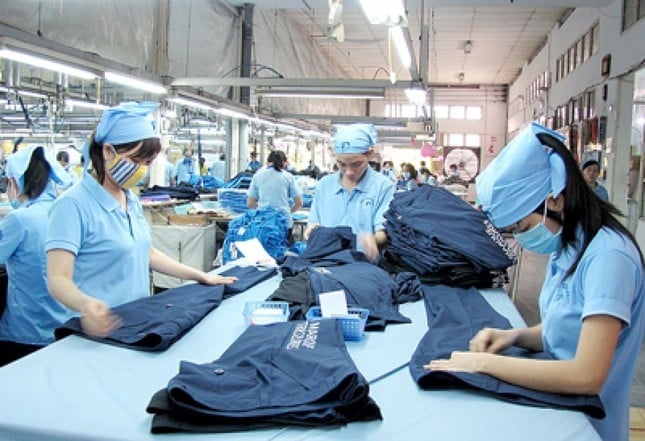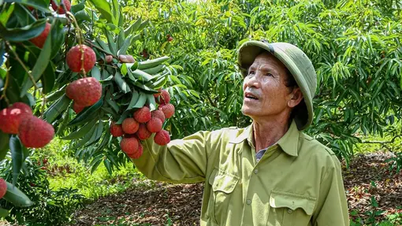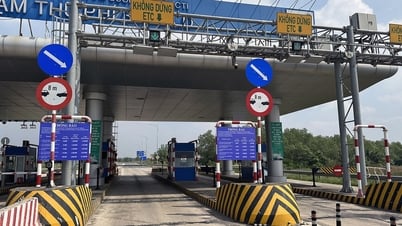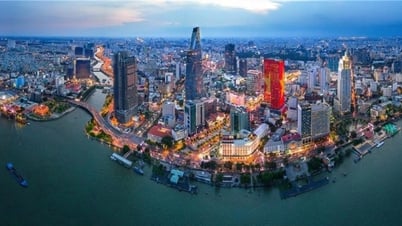 |
| The success rate of Vietnamese shrimp is below 40%, lower than that of Ecuador (90%) and India (60 - 70%). (Source: Industry and Trade Newspaper) |
"Diagnosing" Vietnamese shrimp
According to the Vietnam Association of Seafood Exporters and Producers (VASEP), shrimp export turnover in May 2023 reached 331 million USD, down 28% compared to the same period last year. In general, in the first 5 months of 2023, Vietnam's shrimp exports reached about 1.4 billion USD. Vietnam's shrimp exports have declined since August 2022 until now.
The main reason for this decline, according to Mr. Le Van Quang - Chairman of the Board of Directors, General Director of Minh Phu Seafood Corp, is that the shrimp industry is facing great market pressures such as the global economic recession and reduced purchasing power. Shrimp prices have decreased due to oversupply and reduced business profit margins.
However, the core problem of the Vietnamese shrimp industry today is competitiveness. Mr. Le Van Quang analyzed and compared the cost of shrimp production between 3 competitors: Vietnam, Ecuador, India, the cost of farmed shrimp in Vietnam (4.8 - 5.0 USD/kg) is 100% higher than that of Ecuador (2.3 - 2.4 USD/kg) and more than 30% higher than that of Indian shrimp (3.4 - 3.8 USD/kg).
The success rate of Vietnamese shrimp is below 40%, lower than that of Ecuador (90%) and India (60 - 70%). The survival rate of Vietnamese shrimp in commercial farming is low due to the lack of proactive selection and production of shrimp breeds with good resistance to adverse environmental conditions.
The root cause of the above situation is due to the characteristics of shrimp farming in Vietnam, which is small-scale, household farming, each family only farms 1-3 hectares and does not have its own water supply and drainage channels. Therefore, the survival rate of shrimp is low. Small-scale shrimp farming also makes investment in infrastructure, roads, and transportation for farming areas very difficult.
“Vietnam’s shrimp farming density is up to 250-500 shrimp/m2, India’s is 60 shrimp/m2 while Ecuador’s is only 20-30 shrimp/m2. Vietnam’s shrimp farming density is high, higher than the ecological carrying capacity and pond management capacity, leading to great risks. The prices of essential raw materials for shrimp farming are higher than the actual price when they reach shrimp farmers,” said Mr. Le Van Quang.
Another problem that businesses have reported is that the situation of raising shrimp with antibiotics costs about 10 trillion VND each year. This cost arises from the cost of taking samples to test for antibiotics in the farming area, in the factory, before import, and the time of storage. Of course, these costs are all added to the price of shrimp. This situation causes Japan to inspect 100% of goods from Vietnam while India and Thailand do not.
Mr. Vo Van Phuc - Chairman of the Board of Directors, General Director of Vietnam Clean Seafood Joint Stock Company assessed that the global crisis is unknown when it will end. Therefore, the consumption market will be difficult, plus the strategic challenge of cheap shrimp supply, while supply exceeds demand, causing the price of finished shrimp to drop, even lower than the price of raw materials. Therefore, shrimp farmers suffer losses and shrink, affecting the scale of the shrimp industry.
With high domestic shrimp prices, export enterprises will tend to use imported raw materials from abroad. This means that it will encourage competitors to develop the shrimp farming industry, while at the same time causing the domestic shrimp farming industry to decline and affecting domestic shrimp prices.
“There needs to be a revolution to reduce costs and increase productivity in the shrimp farming sector, emphasizing the role of businesses , ” said Mr. Vo Van Phuc, adding that in the coming time, businesses need to change their thinking so that we can have strong investment in farming areas. This is the premise to solve the challenge of raw material prices. At the same time, it proves to buyers that Vietnamese businesses are doing business honestly and seriously, with certified farming areas and traceable origins.
In addition, the State has a major role in developing the shrimp industry. Accordingly, it is necessary to plan favorable infrastructure for farming areas, such as roads, irrigation canals, land accumulation, other infrastructure, and have policies to support farmers to avoid the decline of the farming profession.
Currently, Vietnam's processing capacity is among the top in the world, but its competitors Ecuador and India are also working hard and can catch up with Vietnam. While India and Ecuador have many strengths in shrimp farming, if they develop the processing stage well, in just 10 years, Vietnam will hardly be able to compete.
Vietnam's exports expected to reach 618 billion USD by 2030
The research report Future of Trade: New Opportunities for High-Growth Corridors recently published by Standard Chartered Bank shows that total global trade turnover in 2023 is expected to reach 32,600 billion USD, with a growth rate of 5%.
Notably, according to the report, Vietnam will be one of the main contributors to global trade growth. Vietnam's exports are expected to reach US$618 billion by 2030, with an annual growth rate of 7%, higher than the global average of 5%.
Ms. Michele Wee - General Director of Standard Chartered Bank Vietnam said that Vietnam has great potential to become a global trade center.
Compared to the report released by Standard Chartered in 2021, this organization expected Vietnam's exports to reach more than 535 billion USD by 2030, after only 2 years, the forecast has increased by 83 billion USD.
On the import side, Standard Chartered estimates that by 2030, Vietnam's import turnover will be 578 billion USD, increasing by an average of 6.9%/year. Thus, Vietnam's trade balance will continue to have a surplus, but mainly belongs to the FDI enterprise sector.
China, South Korea and the US will remain Vietnam’s important trading partners in the coming years. These three markets imported US$171 billion from Vietnam in 2022. In addition, trade with India, Singapore and Indonesia is forecast to grow strongly in the 2021-2030 period.
With increasing international trade, Vietnam has emerged as an important manufacturing location, attracting FDI from Japan, Korea, the US, and the EU. The fields of machinery and electrical equipment, textiles, electronics, etc. will continue to contribute greatly to export activities.
According to Ms. Michele Wee, the world's increasing demand for electronic products, investment activities and sustainable development initiatives will continue to boost Vietnam's exports of key commodities.
Standard Chartered's research opens up expectations for our country's goods exports in the coming time, especially in the context that import and export in the first half of 2023 has been facing many difficulties.
According to statistics from the General Department of Customs, Vietnam's total import-export turnover from the beginning of the year to June 15, 2023 reached more than 287.9 billion USD, down 15.2% over the same period in 2022; of which exports reached 148.87 billion USD, down 12% and imports reached 139.07 billion USD, down 18.4%. The trade balance of goods had a surplus of 9.8 billion USD.
Billion dollar Vietnamese goods in Korea
According to the General Department of Customs, in the context of declining global trade, trade activities between Vietnam and South Korea in the first months of the year were inevitably affected. However, South Korea is still Vietnam's leading important trade partner today.
Statistics from the General Department of Customs show that in the first five months of the year, Vietnam's goods exports to South Korea reached nearly 9.2 billion USD, down 7.1% over the same period last year.
Of which, computer products, electronic products and components reached 1.9 billion USD, phones of all kinds and components 1.3 billion USD, machinery, equipment, other spare parts 1.1 billion USD, means of transport and spare parts 456 million USD... Along with that are strong products such as seafood reaching 293 million USD, vegetables and fruits 86 million USD, coffee 86 million USD, wood and wood products 325 million USD, textiles 1.1 billion USD, footwear 256 million USD...
Korea is in the top 5 customers out of 180 textile and garment export markets of Vietnam, and is also in the top export markets of our country's wooden furniture.
On the other hand, in the first 5 months, imports of goods from South Korea reached 20.3 billion USD, down 26.8% compared to the same period last year. The trade deficit from this market decreased by 38.3%, equivalent to 10.8 billion USD.
 |
| Textiles and garments are one of Vietnam's billion-dollar export products in the Korean market. (Source: Tien Phong Newspaper) |
For many years, Korea has been a market providing machinery, equipment and many input materials for export industries, such as phones, computers, textiles, iron and steel... mainly to serve 100% Korean-owned FDI enterprises in Vietnam.
In 5 months, imports of computers, electronic products and components from Korea reached 10.2 billion USD, machinery, equipment, tools and spare parts 2.3 billion USD, petroleum from Korea reached 1.3 billion USD, raw plastic materials 773 million USD, fabrics of all kinds 638 million USD...
South Korea is one of the largest cotton suppliers to Vietnam and the second largest fabric supplier to Vietnam.
Among the countries and territories from which Vietnam imports machinery, equipment, tools and spare parts, South Korea ranks second after China, but the turnover is one and a half times that of Japan (ranked third).
In 2022, the total bilateral trade turnover between the two countries will reach 87 billion USD. South Korea will become Vietnam's third largest trading partner (after the US and China) and vice versa.
To date, there are about 10,000 Korean enterprises operating in Vietnam, in many fields from services, tourism to processing and manufacturing industries, exporting many Made in Vietnam products. The presence of large Korean corporations is attracting supporting enterprises to help increase the value-added content of Vietnamese production.
Source


![[Photo] Readers line up to visit the photo exhibition and receive a special publication commemorating the 135th birthday of President Ho Chi Minh at Nhan Dan Newspaper](https://vphoto.vietnam.vn/thumb/1200x675/vietnam/resource/IMAGE/2025/5/17/85b3197fc6bd43e6a9ee4db15101005b)



![[Photo] Prime Minister Pham Minh Chinh chairs meeting on science and technology development](https://vphoto.vietnam.vn/thumb/1200x675/vietnam/resource/IMAGE/2025/5/17/ae80dd74c384439789b12013c738a045)
![[Photo] More than 17,000 candidates participate in the 2025 SPT Competency Assessment Test of Hanoi National University of Education](https://vphoto.vietnam.vn/thumb/1200x675/vietnam/resource/IMAGE/2025/5/17/e538d9a1636c407cbb211b314e6303fd)





























![[Photo] Nearly 3,000 students moved by stories about soldiers](https://vphoto.vietnam.vn/thumb/1200x675/vietnam/resource/IMAGE/2025/5/17/21da57c8241e42438b423eaa37215e0e)







































































Comment (0)